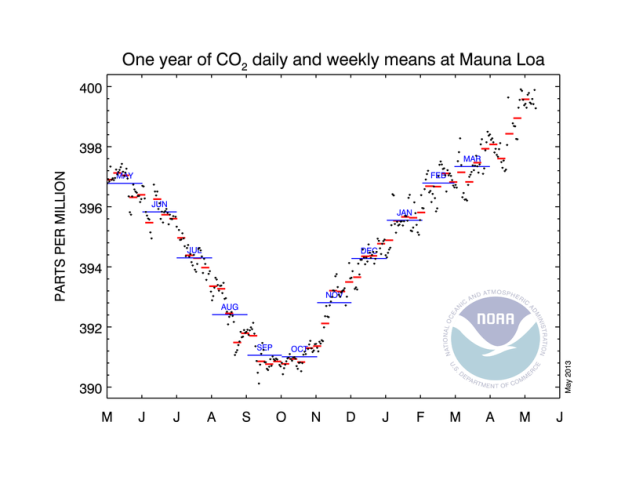Atmospheric CO2 passes 400 ppm
Sunday 12 May 2013
 Probably all teachers covering Option E: Environmental chemistry will refer their students to the graphs produced by the National Oceanic and Atmospheric Administration Mauna Loa Observatory in Hawaii. These graphs show the concentration of carbon dioxide in the atmosphere and have been produced continuously since 1958. What they show is a steady year on year rise in atmospheric carbon dioxide levels. This week the level passed a significant milestone as for the first time ever the reading was above 400 ppm. To put this into perspective before the industrial revolution the value was about 280 ppm. When the readings at Mauna Loa first started the value was about 315 ppm. Currently the rate is increasing at about 2.1 ppm per year. The last time levels reached 400 ppm was three to five million years ago before humans existed and when there was no Arctic ice and sea-levels were up to 40 m higher. Although there is now more awareness of the problems caused by excess carbon dioxide emissions this significant 400 ppm milestone must serve as a ‘wake-up call’ to spur governments and individuals to act to reduce fossil fuel consumption now. Fracking (Induced hydraulic fracturing) may appear to be a temporary solution for providing a cheap source of energy but without control of the carbon dioxide emissions we are condemning future generations to a world ravaged by the consequences of global warming.
Probably all teachers covering Option E: Environmental chemistry will refer their students to the graphs produced by the National Oceanic and Atmospheric Administration Mauna Loa Observatory in Hawaii. These graphs show the concentration of carbon dioxide in the atmosphere and have been produced continuously since 1958. What they show is a steady year on year rise in atmospheric carbon dioxide levels. This week the level passed a significant milestone as for the first time ever the reading was above 400 ppm. To put this into perspective before the industrial revolution the value was about 280 ppm. When the readings at Mauna Loa first started the value was about 315 ppm. Currently the rate is increasing at about 2.1 ppm per year. The last time levels reached 400 ppm was three to five million years ago before humans existed and when there was no Arctic ice and sea-levels were up to 40 m higher. Although there is now more awareness of the problems caused by excess carbon dioxide emissions this significant 400 ppm milestone must serve as a ‘wake-up call’ to spur governments and individuals to act to reduce fossil fuel consumption now. Fracking (Induced hydraulic fracturing) may appear to be a temporary solution for providing a cheap source of energy but without control of the carbon dioxide emissions we are condemning future generations to a world ravaged by the consequences of global warming.

